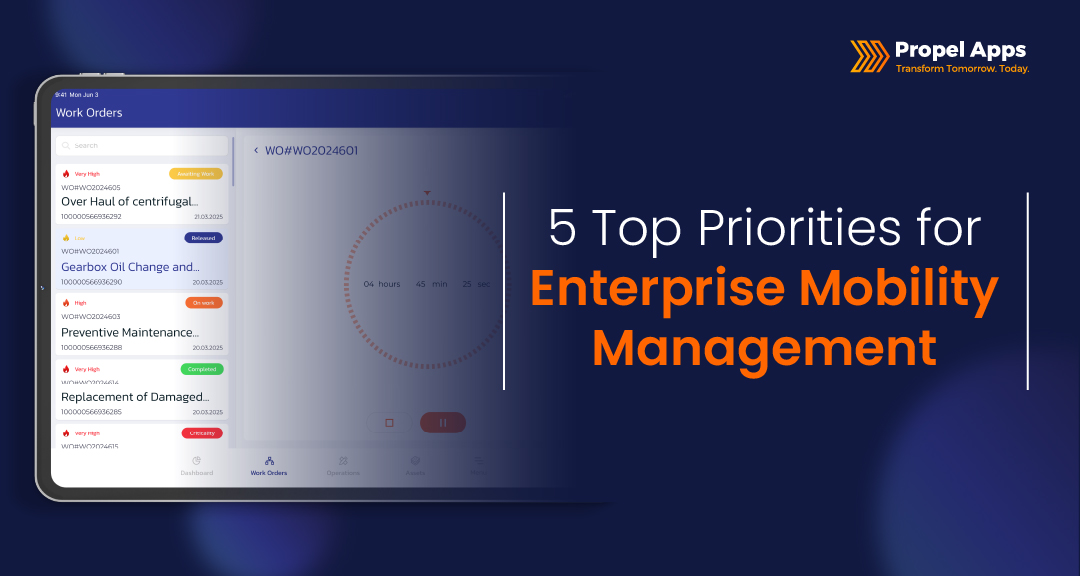
Enterprise mobility prioritizes workforce mobilization and customer engagement, driving efficiency, RoI, and connecting with mobile-first disruptors, making mobile apps a competitive factor. The workforce in warehouses faces challenges in device sharing and operating them independently. Enterprise Mobility Management (EMM) will enable them to achieve productivity, and mobile technology plays a critical role in digital transformation.

Any firm looking for corporate mobile apps is driven primarily by aspects that increase productivity and efficiency. However, in this blog, we will discuss the main areas where mobility leaders would want to invest and get the expected benefits with the help of Enterprise Mobility Management strategies.
The Enterprise Mobility Management market size is projected to grow at a 10.3% CAGR to reach USD 63.6 billion by 2026, fueled by the increasing mobile workforce, which enables remote work and access to corporate data. Following are the 5 main areas where enterprise mobility leaders are most likely to invest:
Mobile app development stands on top of all the investment priorities for mobility leaders. The development of enterprise mobile apps is becoming more significant due to the cost savings and productivity gains it offers. Enterprise Mobility Management plays a pivotal role in supporting the deployment, monitoring, and updating of these apps across devices. Mobility leaders might choose to either purchase or develop apps internally. While the latter allows businesses to create applications as needed, the former is a quicker method for mobilizing any business. Propel Apps is a mobile solution provider that offers over 100 turnkey mobile solutions for every use case, thereby mitigating enterprise mobility challenges across every major business segment.
MAM uses techniques like SDKs, containerization, and device/app level MAM to separate business data from personal data on the same device, making this the second highest priority for mobility leaders. Enterprise Mobility Management integrates seamlessly with MAM to provide complete visibility and control over corporate apps. In the BYOD era, mobile application management is crucial because it provides IT teams with a more detailed way to monitor and secure corporate data across all enterprise mobility solutions.
Mobile apps and devices are increasingly being targeted by threats and data exploitation schemes due to their widespread use. As a critical component of Enterprise Mobility Management, application security ensures corporate data remains protected across all mobile endpoints. Businesses will continue to spend heavily in this area to prevent vulnerabilities.
Gone are the days of clunky UX. Mobile users demand seamless, intuitive interfaces for executing transactions on small devices. Enterprise Mobility Management supports this by ensuring optimal app performance and usability across diverse devices and platforms. Companies are leveraging UX design to enhance user satisfaction and increase engagement. Tools like Design Thinking further help companies such as Airbnb and Hyatt in increasing revenues and brand value.
AI and ML are revolutionary technologies that are rapidly transforming industries such as manufacturing, transportation, and financial services. When integrated with Enterprise Mobility Management, these technologies empower organizations to automate repetitive tasks, analyze complex data, and personalize user experiences, making mobile processes smarter, more reliable, and efficient.
Outlined below are some of the other domains in the priority list of enterprise mobility leaders, often part of a comprehensive Enterprise Mobility Management strategy:
To sum up, mobility leaders in an organization prefer leveraging emerging technologies while developing or adopting an enterprise mobile solution backed by Enterprise Mobility Management. This ensures best-in-class user experience, adequate control, and enhanced security for their employees in a mobile-first landscape.
Propel Apps, an award-winning enterprise mobility solutions provider, designs custom mobile strategies for organizations using Oracle and SAP ERPs. With over 100+ mobile app project implementation experience, Propel Apps helps organizations redefine business processes across various industries, including wholesale, retail, manufacturing, finance, transportation, and logistics—with Enterprise Mobility Management at the core of their offerings.
To learn how our mobile supply chain management solutions can help effective user adoption, enhance security, and above all spearheading your digital transformation initiatives, schedule a free demo with us.